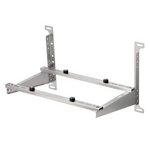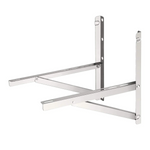
- Cooling Capacity of the unit
- Unit size
Window AC Cooling Capacity
BTU Definition
BTU means British Thermal Units. In air conditioning, BTU means the amount of heat that a unit can remove in one hour. So the higher the BTU rating, the higher the amount of heat that can be removed.
Why is it important to select the correct BTU rating?
- If you choose a higher rating than the one you need, you may have to pay more than necessary for your electric bill.
- On the other hand, if you choose a lower rating, you may not achieve your desired temperature.
BTU Calculator
Follow these steps to select the correct rating:
1. Select the basic cooling capacity according to your space's area:
- 8000BTU window air conditioner - For spaces up to 350sq feet
- 10000BTU window air conditioner - For spaces up to 450sq feet
- 12000BTU window air conditioner - For spaces up to 550sq feet
|
Lots of sunlight or facing West or Southwest: increase BTUs by 10%
Not much sunlight/ facing North or Northeast: decrease BTUs by 10%
|
|
Poor insulation: add 15% to suggested capacity
|
|
More than 2 people? Add 600 BTUs for each additional person
|
|
Kitchen or other warm rooms: Increase capacity by 4000 BTUs
|
If you only need to use your air conditioner during the night, you can reduce the cooling capacity.
|
Running air conditioner at night: Reduce capacity by 30%
|
|
High ceiling: Go for a higher capacity
|
|
Open floor plan: Make sure to measure the whole area
|
Window AC Sizing
For window air conditioners, the unit doesn't need to be the same size as the window, because most units come with adjustable panels. Below are the dimensions needed for each type of unit from TOSOT (please note that we're not distributing 6000BTU units at this moment):

Need an Air Conditioner?
If you've decided the size of aircon that you want to get, you can now select your favorite at www.tosotdirect.com:
Other articles you may like:
How to Select the Correct Dehumidifier
Want more tips like these?
To stay updated with all of our tips, all you need to do is sign-up to our newsletter:
Use information at your own risk: The information presented is intended for educational purposes only and is not intended to be a substitute for professional advice, diagnosis or treatment. Never disregard professional medical or home improvement advice. The information and suggestions should be discussed with a professional. You are responsible for independently verifying the information if you intend to rely upon or use it in any way. You use all information at your own risk.






